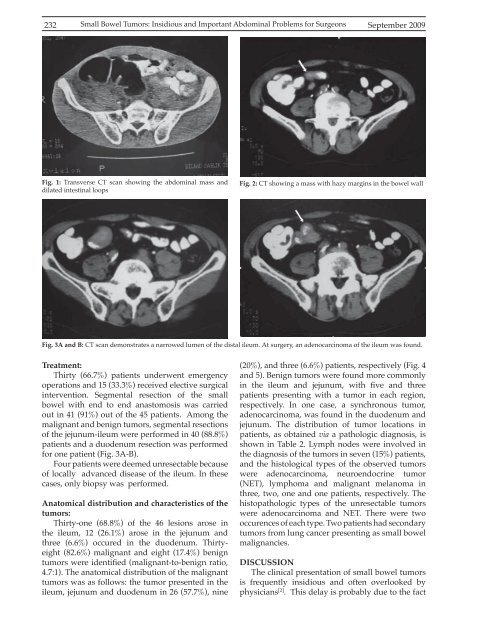Vol 41 # 3 September 2009 - Kma.org.kw
Vol 41 # 3 September 2009 - Kma.org.kw
Vol 41 # 3 September 2009 - Kma.org.kw
You also want an ePaper? Increase the reach of your titles
YUMPU automatically turns print PDFs into web optimized ePapers that Google loves.
232<br />
Small Bowel Tumors: Insidious and Important Abdominal Problems for Surgeons<br />
<strong>September</strong> <strong>2009</strong><br />
Fig. 1: Transverse CT scan showing the abdominal mass and<br />
dilated intestinal loops<br />
Fig. 2: CT showing a mass with hazy margins in the bowel wall<br />
Fig. 3A and B: CT scan demonstrates a narrowed lumen of the distal ileum. At surgery, an adenocarcinoma of the ileum was found.<br />
Treatment:<br />
Thirty (66.7%) patients underwent emergency<br />
operations and 15 (33.3%) received elective surgical<br />
intervention. Segmental resection of the small<br />
bowel with end to end anastomosis was carried<br />
out in <strong>41</strong> (91%) out of the 45 patients. Among the<br />
malignant and benign tumors, segmental resections<br />
of the jejunum-ileum were performed in 40 (88.8%)<br />
patients and a duodenum resection was performed<br />
for one patient (Fig. 3A-B).<br />
Four patients were deemed unresectable because<br />
of locally advanced disease of the ileum. In these<br />
cases, only biopsy was performed.<br />
Anatomical distribution and characteristics of the<br />
tumors:<br />
Thirty-one (68.8%) of the 46 lesions arose in<br />
the ileum, 12 (26.1%) arose in the jejunum and<br />
three (6.6%) occured in the duodenum. Thirtyeight<br />
(82.6%) malignant and eight (17.4%) benign<br />
tumors were identified (malignant-to-benign ratio,<br />
4.7:1). The anatomical distribution of the malignant<br />
tumors was as follows: the tumor presented in the<br />
ileum, jejunum and duodenum in 26 (57.7%), nine<br />
(20%), and three (6.6%) patients, respectively (Fig. 4<br />
and 5). Benign tumors were found more commonly<br />
in the ileum and jejunum, with five and three<br />
patients presenting with a tumor in each region,<br />
respectively. In one case, a synchronous tumor,<br />
adenocarcinoma, was found in the duodenum and<br />
jejunum. The distribution of tumor locations in<br />
patients, as obtained via a pathologic diagnosis, is<br />
shown in Table 2. Lymph nodes were involved in<br />
the diagnosis of the tumors in seven (15%) patients,<br />
and the histological types of the observed tumors<br />
were adenocarcinoma, neuroendocrine tumor<br />
(NET), lymphoma and malignant melanoma in<br />
three, two, one and one patients, respectively. The<br />
histopathologic types of the unresectable tumors<br />
were adenocarcinoma and NET. There were two<br />
occurences of each type. Two patients had secondary<br />
tumors from lung cancer presenting as small bowel<br />
malignancies.<br />
DISCUSSION<br />
The clinical presentation of small bowel tumors<br />
is frequently insidious and often overlooked by<br />
physicians [2] . This delay is probably due to the fact
















